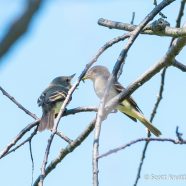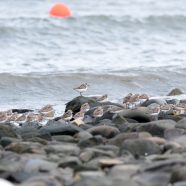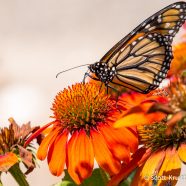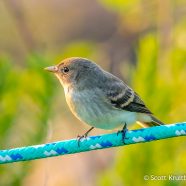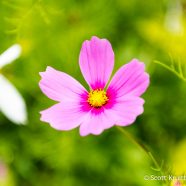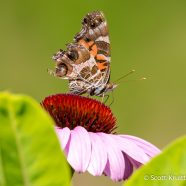Fledgling Flycatcher
While some Willow Flycatchers (Empidonax traillii) are on the way south, like the bird I posted from last Friday evening, others are still finishing up raising the next generation. I photographed this cute family moment this past weekend while they kept their distance from me – please ignore the annoying branches obscuring the scene. I was happy enough to see that they had not fallen victim to a Brown-headed Cowbird. Good thing there are enough caterpillars to go around…any for me? Scott Kruitbosch Conservation & Outreach Coordinator
Read MoreSemipalmated Sandpipers
These Semipalmated Sandpipers were trying to rest and relax along with a few of their friends, and they did not order any balloons for this party. When I can snap two in a single photo…I mean, come on, it’s too much! Scott Kruitbosch Conservation & Outreach Coordinator
Read MoreMonarch on Coneflower
This Monarch butterfly (Danaus plexippus) certainly chose the correct color of coneflower to nectar on as photographed yesterday. It is now egg and caterpillar season! Have you found any on your milkweed?
Read MoreFlycatcher Sunset
This presumed Willow Flycatcher (Empidonax traillii) was a silent companion in a more Willow-frequented location and habitat as the friendly bird watched the sunset with me on Friday. Thick, dark clouds low on the horizon ending up blocking the beauty of the setting sun, and this turned out to be the best photo of the evening. These flycatchers migrate out of our area rapidly in order to stay far away from the cold and keep feeding on those flying meals. It has a long journey remaining as the destination will ultimately be Central or South America. Good luck, buddy! Can you imagine what it...
Read MoreCosmos Flowers
What better way to enjoy art in August than with some more of the most stunning natural sights of summer? Cosmos flowers really stand out from the crowd and look great against the green, almost appearing like a painting.
Read MoreTattered Lady
The American Painted Lady (Vanessa virginiensis) is best identified when nectaring like this by the two large eyespots on the ventral hindwing. The very similar Painted Lady (Vanessa cardui) would have four smaller eyespots in the same place. This individual is tattered and torn, experiencing some wear and tear after being busy on the wing for probably only a couple weeks, or a few at most. Adult life spans are short for many of our butterflies, and they have a lot to get done in such a small window, which makes it all the more important to have plentiful, widespread and organic food...
Read More



